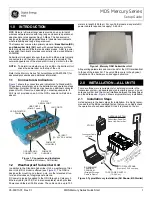
NEO-M9N - Integration manual
• A broadcast ephemeris downloaded from the satellite is a precise representation of a part (for
GPS nominally four hours) of the satellite's true orbit (trajectory). It is not usable for positioning
beyond this validity period because it diverges dramatically from the true orbit afterwards.
• The
AssistNow Autonomous orbit
is an extension of one or more broadcast ephemerides. It
provides a long-term orbit for the satellite for several revolutions. Although this orbit is not
perfectly precise it is a sufficiently accurate representation of the true orbit to be used for
navigation.
• The
AssistNow Autonomous data
is automatically and autonomously generated from
downloaded (or assisted) ephemerides. The data is stored automatically in the on-chip battery-
backed memory (BBR). Optionally, the data can be backed up in external flash memory or
on the host. The number of satellites for which data can be stored depends on the receiver
configuration and may change during operation.
• If no broadcast ephemeris is available for navigation
AssistNow Autonomous
automatically
generates the required parts of the orbits suitable for navigation from the stored data. The
data is also automatically kept current in order to minimize the calculation time once the
navigation engine needs orbits.
• The operation of the
AssistNow Autonomous
feature is transparent to the user and the
operation of the receiver. All calculations are done in the background and do not affect the
normal operation of the receiver.
• The
AssistNow Autonomous
subsystem automatically invalidates data that has become too old
and that would introduce unacceptable positioning errors. This threshold is configurable.
• The prediction quality will be automatically improved if the satellite has been observed multiple
times. Improved prediction quality also positively affects the maximum usability period of the
data.
•
AssistNow Autonomous
considers GPS, GLONASS, Galileo and BeiDou satellites only. It will not
consider satellites on orbits with an eccentricity of >0.05 (e.g., Galileo E18). A single GLONASS
broadcast ephemeris contains information only for approximately 30 minutes. This is not long
enough to extend it in a usable way. Orbit information of each GLONASS satellite must be
collected at least for four hours to generate data.
UBX-19014286 - R07
3 Receiver functionality
Page 38 of 95
C1-Public
















































